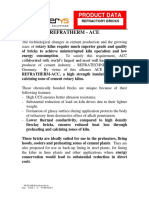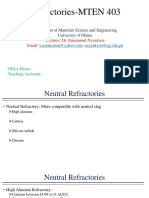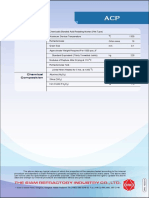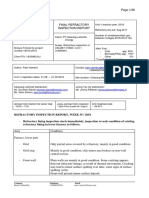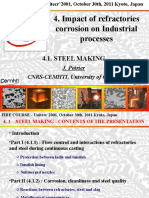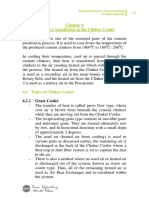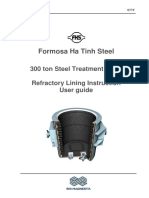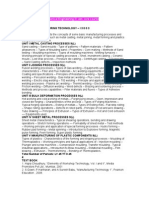0 ratings0% found this document useful (0 votes)
369 viewsPlastic 1
Plastic 1
Uploaded by
coli15This document provides instructions for handling and installing Plibrico plastic refractories. Key points include:
- Plibrico plastics come ready to install without added water and should be stored indoors in cool, frost-free conditions for up to 12 months.
- The installation site must be clean and dry. Pneumatic rammers are used to compact the plastic into a solid, monolithic mass in layers of up to 2.5 inches.
- Proper anchoring, venting, and precautions for hot or cold weather are required to ensure a reliable installation.
Copyright:
© All Rights Reserved
Available Formats
Download as PDF, TXT or read online from Scribd
Plastic 1
Plastic 1
Uploaded by
coli150 ratings0% found this document useful (0 votes)
369 views7 pagesThis document provides instructions for handling and installing Plibrico plastic refractories. Key points include:
- Plibrico plastics come ready to install without added water and should be stored indoors in cool, frost-free conditions for up to 12 months.
- The installation site must be clean and dry. Pneumatic rammers are used to compact the plastic into a solid, monolithic mass in layers of up to 2.5 inches.
- Proper anchoring, venting, and precautions for hot or cold weather are required to ensure a reliable installation.
Copyright
© © All Rights Reserved
Available Formats
PDF, TXT or read online from Scribd
Share this document
Did you find this document useful?
Is this content inappropriate?
This document provides instructions for handling and installing Plibrico plastic refractories. Key points include:
- Plibrico plastics come ready to install without added water and should be stored indoors in cool, frost-free conditions for up to 12 months.
- The installation site must be clean and dry. Pneumatic rammers are used to compact the plastic into a solid, monolithic mass in layers of up to 2.5 inches.
- Proper anchoring, venting, and precautions for hot or cold weather are required to ensure a reliable installation.
Copyright:
© All Rights Reserved
Available Formats
Download as PDF, TXT or read online from Scribd
Download as pdf or txt
0 ratings0% found this document useful (0 votes)
369 views7 pagesPlastic 1
Plastic 1
Uploaded by
coli15This document provides instructions for handling and installing Plibrico plastic refractories. Key points include:
- Plibrico plastics come ready to install without added water and should be stored indoors in cool, frost-free conditions for up to 12 months.
- The installation site must be clean and dry. Pneumatic rammers are used to compact the plastic into a solid, monolithic mass in layers of up to 2.5 inches.
- Proper anchoring, venting, and precautions for hot or cold weather are required to ensure a reliable installation.
Copyright:
© All Rights Reserved
Available Formats
Download as PDF, TXT or read online from Scribd
Download as pdf or txt
You are on page 1of 7
1
Instructions for Handling
And Installing
Plibrico Plastic Refractories
2
INSTRUCTIONS FOR HANDLING AND INSTALLING
PLIBRICO PLASTIC REFRACTORIES
To assure a completed installation that will be
reliable and lasting, we recommend that you read
these instructions through before proceeding.
Pre-Installation Considerations
Material Consistency & Characteristics
Plibrico plastic refractories are stiff, moist, putty-like
materials. Upon leaving the factory, they have the
proper workability and are ready for installation
without the addition of water. To preserve the proper
workability, Plibrico plastic refractories are
protected by moisture retaining wrappers, and
packed in cartons.
Before using a Plibrico plastic, test it for workability
by forming a small handful of material into a ball. It
should be sufficiently pliable to mold and knit into a
homogeneous monolith when rammed with a hand
rammer or pneumatic tool
Grouped according to setting characteristics,
Plibrico plastic refractories fall into 3 general
categories heat-setting, air-setting, and chemical
setting.
Material Storage
Until installed, all Plibrico plastic refractories
should be stored indoors in a cool, frost-free
location. Under these conditions, the materials can
be kept to the limit of their storage life.
The average storage life of air & heat-setting
Plibrico plastic products extends up to 12 months.
The average storage life of chemical-setting
refractories extends from 3 to 6 months. Since there
are variations in the storage life of individual
products, please note the exact storage life for the
product(s) you store.
When heat-setting and air-setting Plibrico plastic
refractories are stored for too long and/or under hot
conditions, the material may become unworkable.
Reconditioning may be possible if no fresh material
is directly available. Consult the Plibrico Technical
Department for the proper procedures.
Chemically bonded plastic refractories cannot be
reconditioned.
Reconditioning Frozen Material
When Plibrico plastic refractories have frozen in the
cartons, the material should be relocated to an
environment where the temperature is 60 degrees F
or more. Material must then be thawed slowly, not
quickly, as fast thawing results in a soft, non-uniform
consistency.
The cubes of refractory should be taken from their
cartons, leaving the protective wrappers intact, and
should be positioned so that warm air can circulate
around them. The plastic refractory product is usable
when it has fully thawed and the original workability
is restored. Normally, the thawing process requires 2
to 3 days.
Equipment Requirements
In addition to the tools normally required for
masonry construction, the installation of Plibrico
plastic refractories requires:
A reciprocating pneumatic rammer with a steel or
hard rubber ramming head operating at
approximately 1200 strokes per minute. The shape of
the ramming head depends upon the material
applied, the shape of the lining, and the users
experience. Bench rammers are recommended for
most jobs, but floor rammers can be used where
space permits.
Sufficient air hose to connect the rammer with the air
supply.
An air manifold with multiple connections if more
than one rammer is used. (The recommended
pressure for pneumatic rammers is 80-90 psi).
Sufficient air volume must be provided to maintain
this pressure on all rammers being used.
A 2.5# hammer for hand ramming in small sections.
A short handled spade for trimming the lining
surface.
A hand tool for cutting expansion joints.
While installing plastic refractories, workers should
follow normal construction safety procedures. Also
refer to Material Safety Data Sheet (MSDS) for
special instructions.
3
Site Preparation
Before beginning the installation of Plibrico plastic
refractory, these precautions should be taken.
1. The site where the Plibrico materials will be installed
must be clean so nothing can contaminate the
refractory. The back-up surface, against which the
Plibrico plastic refractory will be placed, must be
smooth, without wide gaps or cracks, and thoroughly
cleaned.
2. Care must be taken to prevent rain or water from
contacting the refractory during installation and
before bake-out takes place.
3. Care must also be taken to insure that the material
does not freeze in the unfired state.
Forming & Anchoring Provisions
While Plibrico plastic refractories can usually be
installed without forms, the use of forms and/or false
anchoring is necessary in some cases.
Forms are necessary for arches, suspended roofs,
and walls which slope inward. Forms are
recommended where it is desirable to achieve
maximum compaction of the plastic in vertical walls
exposed to severe mechanical load. It can also be
economical to use forms for walls of large size and
thickness.
The forms must be braced and made of strong
material to prevent movement, bending, or vibration
when the material is installed. False anchoring is
necessary when installing chemical setting plastics
overhead. Contact the Plibrico Engineering
department for specific information on forming and
false anchoring methods.
Depending upon the dimensions and position of the
Plibrico refractory lining, it must be provided with
special anchors and supports. These hold and secure
the lining to the outer wall or steel structure and
make it possible to remove or repair one section
without affecting the stability of adjacent sections.
Anchors are not to be used in molten metal contact
situations.
A wide range of Plibrico anchors and supports
provide for all kinds of positions, temperature, and
process conditions. Plibrico does not recommend the
use of round bar type metallic anchors. The type and
quality of anchors and supports as well as their
position are given on the Plibrico drawing. If no
drawing is available, contract Plibricos Engineering
Department and ask for further advice before
proceeding.
Anchor hooks and support brackets must be securely
fastened by an appropriate method to the outer
surface or steel structure prior to installation of the
refractory lining.
CAUTION: When forms are used, ceramic anchor
tiles in their fully extended position should be to
away from the inside face of the form to allow for
trimming. In no case, should the plastic refractory
protrude past or on top of the ceramic tile anchor
after trimming.
Special Weather Conditions
Hot Weather Installation
Plastic refractory installations in warm or tropical
climates require extra precautions due to the high
ambient temperatures normally encountered.
Provisions for cool storage of the Plibrico plastic are
essential, particularly if the product will not be sued
soon after delivery.
During installation, these steps should be taken:
The distance between the cut joints should be
reduced to between 20 and 28.
The distance between vent holes should be 6.
CAUTION: Phosphate-bonded plastics should be
vented immediately before bake out.
Prevent condensation from forming on the surface of
the unfired refractory (which normally results from
high humidity and lower temperatures inside the
furnace than outside) by opening access doors,
combustion air dampers, and flue gas dampers to
create a slight draft. This reduces the risk of surface
condensation, as constant ventilation is the most
efficient preventative measure. Take care to limit
ventilation to prevent excessive surface drying.
Cold Weather Installation
Plastic refractory installations in cold weather also
require extra precautions:
Store plastic refractories in a frost-free warehouse.
Do not install frozen plastic refractories.
Take steps to prevent the material from freezing
during installation.
Take steps to prevent the installed Plibrico plastic
lining from freezing in the unfired state.
If material is accidentally frozen in the cartons, see
the section on reconditioning frozen material. If the
plastic refractory is frozen after installation and
prior to firing see the section on bake-out
instructions.
4
Ramming Procedures
Open the carton and the moisture proof packaging at
all 4 corners of the cube (with the pre-cut slices in a
vertical position). Separate the individual slices with
a trowel or spade.
Ramming - WALLS
Lay a row of either complete or cut Plibrico slabs in
place against the back-up wall, plate, or insulation,
and along the length of the wall or section to be
lined. Never place more than 1 layer, or a 2
thickness, at a time. With the pneumatic or hand
ramming tool, ram the first layer of material
thoroughly into a solid, monolithic mass. This
ramming must be done uniformly and thoroughly. All
ramming should be done by moving in a direction
perpendicular to the length of the work. When
thoroughly done, the plastic should be compacted to
approximately one half the original unrammed
thickness. Voids should not be present, and the slices
should be molded into a monolithic mass.
After ramming the first layer, proceed by placing the
second layer directly on top. For this second layer,
and all succeeding layers, stagger the placement of
the slabs so that the joint between pieces is offset
from the layer below, preventing continuous vertical
joints from being formed.
Ramming of subsequent layers must also be done
thoroughly. Do not ram the next layer against a
smooth surface, as the previous rammed layer must
be roughened before the next layer is placed. This
will give maximum coherence between the 2 layers.
This practice is of great importance in metal contact
applications.
As soon as the Plibrico wall reaches the height of a
row of anchor hooks or support brackets, the anchors
or supports must be fitted to these hooks or brackets
and then embedded into the Plibrico plastic
refractory.
This must be done carefully, fitting each anchor into
the base of the hook, and each support into the base
of the tapered portion of the bracket.
In order to keep anchors flexible, it is recommended
that the connection between the anchor and the hook
be kept free of plastic refractory. All anchors must be
installed in a fully extended position. To do this,
insert a pair of non-metallic wedges between the
anchor and the hook. When the anchor has been
rammed in place, the wedges should be removed.
CAUTION: Never ram directly on a ceramic anchor.
When installing ceramic anchor tile, use a dummy or
spare tile to make a full depth profile in the plastic
refractory. Then set the ceramic anchor tile.
Ramming - ROOFS
Ramming roofs/arches requires forming and the use
of ceramic tile anchors. Chemically setting plastic
refractories additionally require false anchoring
provisions. Consult with your Plibrico representative
or the Plibrico Engineering Department for details.
Ramming - FLOORS
No anchors are required in floor applications.
Ramming should be carried out in a direction as
close to perpendicular to the hot face as possible.
Never face ram the outer surface of a lining.
Trimming
If the Plibrico plastic is not rammed behind forms, a
wall lining may tend to bulge due to vertical
ramming. Therefore, trim off the bulging portion to
the required thickness using a sharp flat blade or a
special pneumatic tool.
The trimming must be done within a short time while
the material is still workable. Trimmed material can
be used again if it is not contaminated with foreign
matter. A clean job site is beneficial.
Joints
During bake-out of a Plibrico installation, the plastic
refractory has a tendency to first shrink and then
expand. It is recommended that provisions be made
for this to occur at preselected places rather than
where cracks are not desired, such as at anchor
locations. To accomplish this, the surface lining must
be provided with cut joints.
The depth of these cut joints should be about 1/5
th
of
the wall thickness, with a maximum depth of 2 on
walls over 12 thick. These joints can be made with a
hand tool.
The cut joints must be made in both horizontal and
vertical directions. Position of cut joints may be
given on the drawing of the refractory lining. Should
no drawing be available, it is recommended that the
joints be cut at distances of about 48. The prime
consideration is to space cut joints between rows of
anchors. If required, the Plibrico Engineering
Department can supply special recommendations
regarding distance between joints and their depths.
CAUTION: Do not cut joints in molten metal contact
areas.
The joints must be cut within a short time after
ramming, while the Plibrico material is still
workable.
Finishing
During the bake-out of the lining, moisture in the
Plibrico plastic refractory will evaporate. In order to
5
facilitate the escape of water vapor and to prevent
spalling of the lining, two measures must be taken
during installation: surface roughening and venting.
When the Plibrico lining is trimmed to the proper
thickness, the surface of the material must be made
rough This can be done by scraping it with a trowel
or special roughening tool. Surface roughening must
be done within a short time after ramming is
completed. Do not finish the Plibrico lining to a
smooth and slick surface.
When trimming, joint cutting, and surface
roughening are completed, vent holes must be made
in the Plibrico lining. The distance between the vent
holes should be about 8 inches, except in molten
metal contact areas. A 3/16 diameter rod or nail
should be used to pierce the lining to a depth of
approximately 50% of the lining thickness, up to a
maximum of 6.
In metal contact areas, only make the vent holes 2
deep and the vent holes should be 18 apart.
Vent holes must be made while the lining can still be
pierced, however not too soon because the vent holes
may close due to external vibration from surrounding
equipment or installation activities. The best time to
make vent holes is immediately before bake-out, if
possible.
THE EASIEST INSTALLATION INSTRUCTIONS:
1. LET US DO IT ALL FOR YOU!
Plibrico skilled installation crews will craft a refractory lining of superior
quality. From tear-out of the worn lining to new lining bake-out, we offer
service so extensive it makes it easy for you to plan and coordinate your project.
Large job or small we can provide the best installation service, combined
with the best refractory products. This results in bottom-line economy for you,
due to our single source capabilities.
Our nation-wide network of Plibrico Sales & Service offices is ready to provide
you with a free estimate for performing every service needed to carry out your
work.
We also draw on the resources of the Engineering Department of Plibrico
Company which, since 1914, has dealt with every phase of refractory enclosure
configuration. We can give you refractory linings computer programmed for
maximum thermal efficiency and cost effectiveness.
Start your work the right way call Plibrico today!
For the name of your local Plibrico representative
Please call (312) 337 9000
Or fax (312) 337 9003
6
Work Interruptions
When the installation of a Plibrico plastic refractory
lining is interrupted, as during a lunch break,
overnight, or over a weekend, or for any reason, the
working surface must be covered with plastic
sheeting to prevent the lining from drying out. When
work resumes, the dried material on the working
surface must be scraped away and the new surface
roughened before ramming begins.
If possible, try to have work interruptions coincide
with where a joint is to me made later. When any
interruption will exceed 8 hours, the installed lining
must be trimmed and provided with cut joints.
Frozen Linings
When an installed plastic refractory lining is frozen,
it must first be thawed very carefully. Since both the
freezing and thawing process can dry the surface of
the lining excessively, it should be sealed with a
plastic or a sealing compound before thawing to
avoid the risk of surface spalling later. Then, the
temperature of the lining must be increase no more
than 25 degree F/hr, up to a maximum of 150 degrees
F. This temperature should be maintained for at least
24 hours. Linings over 9 thick may require a longer
holding time at 150 degrees F. Consult your Plibrico
representative for special instructions. After that,
normal bake-out procedure can be initiated.
Frozen and thawed linings may show higher surface
shrinkage, which does not always affect the quality of
the lining.
For more information about bake-out
procedures, contact Plibricos
Engineering Department for assistance.
Bake out Instructions
Do not allow high drafts through the furnace, which
may cause an undesirable rapid dry-out. A slight
draft is necessary to prevent the formation of
condensation on the lining. However, do not leave
the doors and dampers wide open.
Refractory linings must also be protected from
freezing prior to bake-out!
The bake-out of a Plibrico plastic refractory lining is
of great importance. During this procedure, the
existing free water, which was necessary for the
workability of the material, must evaporate. This
bake-out procedure must take place with a prescribed
temperature increase per hour, depending upon the
amount and type of material installed.
Various grades of Plibrico plastic refractories
require different bake-out rates. Please refer to
Plibricos bake-out schedules for the appropriate
bake-out program. Also, advice is available from
Plibricos Engineering Department on the proper
bake-out procedure for installations that are very
large, or complicated, or of multi-components, or
which involve special processes.
Linings constructed of chemical setting plastics
should be baked out within 1 week after installation.
Thus, you must take this requirement into
consideration when scheduling the work. When bake-
out is delayed beyond this time, the lining must be
covered and carefully sealed with plastic sheeting or
curing compound to prevent drying. Suspended roofs
or chemical-setting plastic should also remain
supported before-bake-out.
Linings constructed of air-setting plastics need not be
baked out immediately. Air bonded materials are
designed to stand in their unfired state for a period of
time, while developing a certain strength at room
temperature.
Flat arches of air-setting plastic require special
curing procedures, ask your Plibrico representative
for specific details.
PLIBRICO COMPANY
1010 N Hooker St
Chicago, IL 60622
Phone (312) 337 9000 Fax (312) 337 9003
Rev02a
7
You might also like
- 005 Installation Manual of Gunning Refractory - R0Document14 pages005 Installation Manual of Gunning Refractory - R0pulakjaiswal85No ratings yet
- ANTEC - Refractory AnchorsDocument114 pagesANTEC - Refractory AnchorstylerstearnsNo ratings yet
- Allied Mineral Refractory Castable - Refractory Cement - Allied MineralDocument2 pagesAllied Mineral Refractory Castable - Refractory Cement - Allied MineralLeo CrisuNo ratings yet
- API936Document6 pagesAPI936coli15No ratings yet
- Handbook of RefractoryDocument331 pagesHandbook of RefractoryAamirMalikNo ratings yet
- Fuel Cell TechnologyDocument19 pagesFuel Cell TechnologyNaresh ChidriNo ratings yet
- Plastic Refractory Instalation RefDocument5 pagesPlastic Refractory Instalation RefHefni OssyanNo ratings yet
- Insulating Refractory Concrete Installation GuideDocument28 pagesInsulating Refractory Concrete Installation Guidesaju varghese100% (1)
- Tutorial For The Steel Ladle SimulationDocument5 pagesTutorial For The Steel Ladle SimulationJavier TrujillanoNo ratings yet
- API Refractory Lining and Burner Brick RequirementDocument29 pagesAPI Refractory Lining and Burner Brick RequirementsprathNo ratings yet
- Data Sheet Greencast 94: DescriptionDocument2 pagesData Sheet Greencast 94: Descriptionmani0% (1)
- (PDF) CFB Refractory RepairDocument1 page(PDF) CFB Refractory RepairManuel CampuzanoNo ratings yet
- The Circle of Refractory Maintenance: Brokk and Bricking SolutionsDocument36 pagesThe Circle of Refractory Maintenance: Brokk and Bricking SolutionsManh PhamNo ratings yet
- How Mixing Affects The Rheology of Refractory Castables - Part IIDocument25 pagesHow Mixing Affects The Rheology of Refractory Castables - Part IIVinh Do ThanhNo ratings yet
- Installation Instruction For Conventional Castables PDFDocument2 pagesInstallation Instruction For Conventional Castables PDFakv_bhelNo ratings yet
- Refractories PDFDocument22 pagesRefractories PDFRinku Singroha (JSHL-QUALITY)No ratings yet
- Insulation Castables Application Procedure - Rev-2 - PDFDocument10 pagesInsulation Castables Application Procedure - Rev-2 - PDFNatarajan MurugesanNo ratings yet
- Refractory Calculation Sheet For C-102 PDFDocument2 pagesRefractory Calculation Sheet For C-102 PDFAttyubNo ratings yet
- 2012 Lecture BKC Insulations & RefractoryDocument30 pages2012 Lecture BKC Insulations & Refractorydeb_bratapalNo ratings yet
- Investigation of Refractory Concrete Failure in Furnaces of Metals IndustryDocument8 pagesInvestigation of Refractory Concrete Failure in Furnaces of Metals IndustryAditya PrajasNo ratings yet
- ANH Europe Seminar 2012 1Document208 pagesANH Europe Seminar 2012 1Abdullrahman AlzahraniNo ratings yet
- Refractory Anchors Catalogue PDFDocument114 pagesRefractory Anchors Catalogue PDFhappy50% (2)
- Chapter3-Overview On Carbon Bond RefractoriesDocument18 pagesChapter3-Overview On Carbon Bond RefractoriesNguyễn ChungNo ratings yet
- Presentation On Refractories By: Haleem Haider Farrukh Shahzad Muzammil JavedDocument23 pagesPresentation On Refractories By: Haleem Haider Farrukh Shahzad Muzammil JavedwatcharpNo ratings yet
- REfactory LiningDocument20 pagesREfactory LiningVkp PNo ratings yet
- Product Data: Refratherm - AceDocument7 pagesProduct Data: Refratherm - AceMuntandwe georgeNo ratings yet
- Refractories OverviewDocument54 pagesRefractories OverviewArun Kumar S.L.No ratings yet
- Project (Final) NEW - OriginalDocument26 pagesProject (Final) NEW - OriginalNagesh BhadoleNo ratings yet
- Blast Furnace Trough CastablesDocument104 pagesBlast Furnace Trough CastablesPriyabrataTaraiNo ratings yet
- Neutral Refractories 2021Document36 pagesNeutral Refractories 2021Daniel AppuingNo ratings yet
- RefractoryDocument25 pagesRefractoryRoed Alejandro LlagaNo ratings yet
- Bricks and Shapes 2Document6 pagesBricks and Shapes 2nay den100% (1)
- AGC PlibricoDocument11 pagesAGC Plibricochandirandelhi100% (2)
- Physical Properties Classification: The Siam Refractory Industry Co., LTDDocument23 pagesPhysical Properties Classification: The Siam Refractory Industry Co., LTDManekGorisNo ratings yet
- Corrosion in Cement Plants Caused by Acid GasesDocument5 pagesCorrosion in Cement Plants Caused by Acid GasesAnonymous NxpnI6jCNo ratings yet
- GHJDocument26 pagesGHJShahNo ratings yet
- Impact of Refractories Corrosion On Industrial Processes: 4.1. Steel MakingDocument93 pagesImpact of Refractories Corrosion On Industrial Processes: 4.1. Steel MakingniviNo ratings yet
- 85% High Alumina Refractory Brick Specs: Brand Properties DL-87WDocument2 pages85% High Alumina Refractory Brick Specs: Brand Properties DL-87WHasan Ash100% (1)
- Anchor - 0396Document44 pagesAnchor - 0396Rudra PanditNo ratings yet
- Refractory LiningDocument3 pagesRefractory LiningzhanghuiNo ratings yet
- Application Procedure ROCKHARD-90Document4 pagesApplication Procedure ROCKHARD-90JCSNo ratings yet
- LIIL RefractoryDocument33 pagesLIIL RefractoryMOHD AZAMNo ratings yet
- Refractory Lining of Blast Furnace PDFDocument11 pagesRefractory Lining of Blast Furnace PDFceng el samiuNo ratings yet
- Furan C - Product Information Sheet PDFDocument2 pagesFuran C - Product Information Sheet PDFAnuradhaPatraNo ratings yet
- Working On RefractoryDocument76 pagesWorking On RefractoryRahul BishnoiNo ratings yet
- Chapter 6 Final A5 EditDocument16 pagesChapter 6 Final A5 EditkINGNo ratings yet
- Castable RefractoryDocument4 pagesCastable RefractorySarbajitMannaNo ratings yet
- Causes of Failure and Repairing Options PDFDocument17 pagesCauses of Failure and Repairing Options PDFSubhash AhujaNo ratings yet
- PDF ST Aluminium e M D 9 2018.en.31Document14 pagesPDF ST Aluminium e M D 9 2018.en.31Argenis Emmanuel Rodriguez MarianoNo ratings yet
- FIRE Compendium Series: Refractory Castable EngineeringDocument2 pagesFIRE Compendium Series: Refractory Castable EngineeringKhaled BOUALINo ratings yet
- Slide Gate System DevelopmentDocument14 pagesSlide Gate System DevelopmentA.S.M. Mosayeb RafiNo ratings yet
- Overview - RefractoriesDocument41 pagesOverview - RefractoriesRogerShNo ratings yet
- REFractories FOR GLASS-TRL PDFDocument24 pagesREFractories FOR GLASS-TRL PDFram cNo ratings yet
- BF Runner Mix 20 MT VesuviusDocument3 pagesBF Runner Mix 20 MT VesuviusSaumit PalNo ratings yet
- Blanket and Wallpaper Linings Design and Installation ManualDocument12 pagesBlanket and Wallpaper Linings Design and Installation ManualMarco Antonio Guevara MartínezNo ratings yet
- Yüksek F R N Kanallar Nda Kendili Inden Ak C Boksit Esasl Dökülebilirlerin Geli TirilmesiDocument8 pagesYüksek F R N Kanallar Nda Kendili Inden Ak C Boksit Esasl Dökülebilirlerin Geli TirilmesiOrkun KorkmazNo ratings yet
- FHS Ladle Installation Manual Incld OPI - 10.5.2018Document28 pagesFHS Ladle Installation Manual Incld OPI - 10.5.2018Nguyễn ChungNo ratings yet
- Calculation On RefrectoryDocument3 pagesCalculation On RefrectorymishtinilNo ratings yet
- Plibrico Plastic Inst 11Document5 pagesPlibrico Plastic Inst 11Женя МедведитцынNo ratings yet
- Plibrico Plastic Inst 11Document5 pagesPlibrico Plastic Inst 11geortsakiNo ratings yet
- Installation P1 Plastics - StandardDocument2 pagesInstallation P1 Plastics - StandardDeni RahmatNo ratings yet
- Installation Instructions Insulating Refractory Materials Revision 2 15-12-2010Document2 pagesInstallation Instructions Insulating Refractory Materials Revision 2 15-12-2010konstantasNo ratings yet
- Arc For Refractory Brick Lining Jobs in All Plants at RCF, Trombay Site MES/602/L/1213/018 Dated 21.02.2013 15.03.2013 15.03.2013Document37 pagesArc For Refractory Brick Lining Jobs in All Plants at RCF, Trombay Site MES/602/L/1213/018 Dated 21.02.2013 15.03.2013 15.03.2013coli15No ratings yet
- QA Procedures Summary PDFDocument15 pagesQA Procedures Summary PDFcoli15No ratings yet
- Set-Up and Welding: Inspecting The WeldDocument1 pageSet-Up and Welding: Inspecting The Weldcoli15No ratings yet
- Gfs Qa Manual 2009Document34 pagesGfs Qa Manual 2009coli15No ratings yet
- Radialign Brick Alignment Device - QuestionsDocument1 pageRadialign Brick Alignment Device - Questionscoli15No ratings yet
- Astm PDFDocument5 pagesAstm PDFJacildo Soares Cavalcante CavalcanteNo ratings yet
- MSDocument18 pagesMSBarham Sabir MahmoodNo ratings yet
- 6 Chapter 6 Acids and Bases ModDocument57 pages6 Chapter 6 Acids and Bases ModShadi Abu DoghmaNo ratings yet
- Ammonia PlantDocument10 pagesAmmonia PlantHemal Patel Sam75% (4)
- Catalogue of Hunan Carbon SteelDocument31 pagesCatalogue of Hunan Carbon Steeljennysong0720No ratings yet
- Protimeter - Damp MeterDocument13 pagesProtimeter - Damp MeterReparaçõesIlimitadasNo ratings yet
- CTSC Matric Masterclasses Rates-of-Reaction 2020-1Document10 pagesCTSC Matric Masterclasses Rates-of-Reaction 2020-1Sumia QuashieNo ratings yet
- Clinoptilolite Zeolite - Technical Data SheetDocument3 pagesClinoptilolite Zeolite - Technical Data SheetrafaeldiserioNo ratings yet
- Manufacturing Processes SyllabusDocument14 pagesManufacturing Processes SyllabusdeekamittalNo ratings yet
- FLEXICELL XLPE Installation Guide Jan 2021Document16 pagesFLEXICELL XLPE Installation Guide Jan 2021RemielNo ratings yet
- X-Ray Diffraction Study of M7C3 Carbide Within A High Chromium White Iron PDFDocument4 pagesX-Ray Diffraction Study of M7C3 Carbide Within A High Chromium White Iron PDFUlises Quintana CarhuanchoNo ratings yet
- 316 LSDocument5 pages316 LSRouse ToxquiNo ratings yet
- Tansingh Chouhan: MCI 100 Control System Ver 1.0Document11 pagesTansingh Chouhan: MCI 100 Control System Ver 1.0Santosh KumarNo ratings yet
- Subframe PDFDocument2 pagesSubframe PDFkian hong100% (1)
- Standard Guidelines For The Design and Lnstallation of Pile FoundationsDocument3 pagesStandard Guidelines For The Design and Lnstallation of Pile FoundationsnobleNo ratings yet
- Metalworking BrochureDocument6 pagesMetalworking BrochurechayanunNo ratings yet
- Tig255i Owners Manual PDFDocument30 pagesTig255i Owners Manual PDFkokoNo ratings yet
- My Publications - CHM 202-COLLOID & SURFACE CHEMISTRY-IDocument20 pagesMy Publications - CHM 202-COLLOID & SURFACE CHEMISTRY-IAjiir DivineNo ratings yet
- Aus: Daniel Schroeder "An Introduction To Thermal Physics", Pearson VerlagDocument7 pagesAus: Daniel Schroeder "An Introduction To Thermal Physics", Pearson VerlagPranayYadavNo ratings yet
- Chelating Resin - Product.informationDocument2 pagesChelating Resin - Product.informationu77No ratings yet
- Solid StateDocument24 pagesSolid Statehanumanpujari.77No ratings yet
- Class 5 Science Chapter 4 Test 1Document7 pagesClass 5 Science Chapter 4 Test 1imranalisheikh973No ratings yet
- Calculations of Pile Capacity of Pile: K EI TDocument5 pagesCalculations of Pile Capacity of Pile: K EI Tgaurav sharmaNo ratings yet
- Soldering in RPDDocument4 pagesSoldering in RPDPraveen KumarNo ratings yet
- Table of Forces For TrussDocument7 pagesTable of Forces For TrussSohail Kakar100% (1)
- Percent CompositionpreapDocument10 pagesPercent CompositionpreapvishakhshuklaNo ratings yet
- Infrastructures: Feasibility of Reusing Damaged Steel Beams in Temporary StructuresDocument24 pagesInfrastructures: Feasibility of Reusing Damaged Steel Beams in Temporary Structureslouis donyNo ratings yet
- Liquid-Liquid Transition and Critical Point in SulfurDocument10 pagesLiquid-Liquid Transition and Critical Point in SulfurPurboPathikNo ratings yet
- Classification of Occupancies 4.1Document3 pagesClassification of Occupancies 4.1Ravi ShankarNo ratings yet
- Chemistry SumerDocument32 pagesChemistry Sumerwinston loboNo ratings yet

























